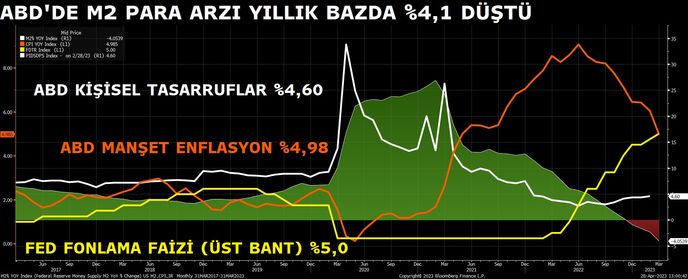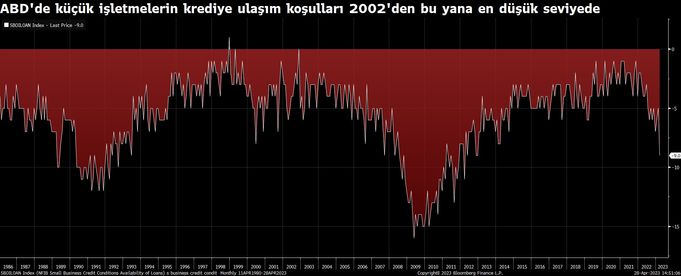Will the decline in money deepen the recession?

TUĞBA ÖZAY – BLOOMBERG HT RESEARCH
The relationship between money supply and inflation is a highly debated issue both in the markets and in the academic environment. According to the money supply theory; An increase in the money supply increases inflation, while a decrease in the money supply decreases inflation. However, inflation does not necessarily increase when the money supply increases. There are other factors that affect inflation as well.
For example, a decrease in a country’s production may cause the general level of prices to rise. In addition, other factors such as monetary policies, tax policies, international trade and so on can also affect inflation. While the money supply-inflation relationship is generally less obvious in developed countries, there is a stronger relationship in developing countries.
The increase in the M2 money supply, which started to increase in March 2020 with the pandemic in the USA, started to decline after rising above 26 percent. One month after the money supply started to increase, the savings rate of households in the USA was around 34 percent. The household savings rate, which was 7.6 percent in 2019, increased to 33.7 percent in 2020. This data means that US households have historically recorded the highest savings rate.
The relationship between the money supply and savings is not a simple causal relationship. When the money supply increases, savings rates are expected to rise because more money supply lowers interest rates, which reduces the attractiveness/potential return on saving. However, other factors also affect savings rates, so these factors also need to be considered in order to understand the full impact of changes in the money supply. For example, a high level of income may increase consumers’ propensity to save because they can save more when they have more income. Also, higher interest rates can encourage saving, as it makes it more attractive to save in accounts with higher interest rates. On the other hand, the increase in inflation and erosion in economic expectations may reduce the tendency of consumers to save.
Households who lost their jobs and experienced a decrease in their income during the pandemic period used their savings. The chart below shows the change in personal savings rate, money supply and inflation as of April 2020, one month after the money supply started to increase.
As can be seen from the chart, despite the increase in the money supply in the USA, the saving tendency of households decreased and inflation continued to rise. Since March 2021, we observe that the decrease in the money supply has continued. The U.S. M2 money supply was $20.8 trillion in March, down 4.1 percent year-on-year, the biggest drop since 1959, almost twice as much in the previous month.
On the other hand, while the M2 money supply is falling at the fastest rate since 1933 on an annual basis, the rate of decline is increasing even more. In the last 3 months, M2 has fallen at an annual rate of over 8 percent. Its effect on inflation seems delayed. However, the only difference is that the dates when inflation started to fall coincide with the dates when the Fed started to increase interest rates. Remarkably, since the Great Depression, the Fed has never raised interest rates while the M2 money supply has fallen. However, the inability to control inflation forced the Fed to increase interest rates. While increasing interest rates along with the shrinking money supply reduced inflation, savings rates started to increase again.
What is the risk of a contraction in the money supply?
While the decrease in the money supply causes the economic activity to slow down and the growth potential of the enterprises decreases, this may cause an increase in the unemployment rate and the onset of economic recession. On the other hand, if there is an increase in the demand for money in circulation at a time when the money supply decreases, this increase may cause prices to rise and trigger a new increase in inflation. Another effect is that the decrease in the money supply limits banks’ ability to lend.
Because lending by banks means they create money, which increases the money supply. The decrease in banks’ appetite for lending creates a meltdown in the money supply. This limits the ability of banks, businesses and individuals to respond to loan requests. This is the situation in the USA right now.
The chart below shows the change in terms of access to credit for small businesses in the US. Access to credit for small businesses in the US contracted the most since 2002 in March.
Policymakers in the US have tried to avoid a decline in the money supply since the Great Depression. One of the biggest reasons for this is the deflationary effect of the decrease in the money supply. Compared to high inflation, the decrease in the M2 money supply involves the potential for deflationary risk, which is a greater risk.
Important periods in history when the money supply contracted:
The Great Depression of 1929: The Great Depression, which began in 1929, caused a major contraction in the US economy. Bankruptcy, increased unemployment, and reduced agricultural and industrial production led to a contraction in the money supply.
Fighting inflation in the 1980s: In the 1980s, the US economy implemented a series of tight monetary policies to combat inflation. These policies led to a contraction in the money supply.
2008 Global Financial Crisis: The financial crisis that started in the USA and other countries in 2008 led to a contraction in the money supply. During the crisis, major banks went bankrupt, unemployment rates rose, and banks’ lending facilities were restricted.
Covid-19 Pandemic: In 2020, the Covid-19 pandemic caused a major contraction in the US economy. Although the money supply increased with the use of monetary policies and fiscal incentives, the money supply also contracted, especially due to the bankruptcy of businesses and the increase in unemployment.
These crises, and especially those experienced during the Great Depression, shed light on the dangers and consequences of the contraction in the M2 money supply. That is, a decrease in the money supply; It can cause negative consequences such as economic instability, unemployment, inflation and financial crisis. In summary; By ignoring the decrease in M2, the Fed maintains a tight monetary policy stance, increasing the risk of a future deflationary collapse. If the Fed does not learn from its past experiences, it may have to go for a new and larger quantitative easing after a recessionary economy. This may cause the USA to relive the high inflation period of the 1970s and 80s.






